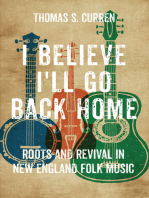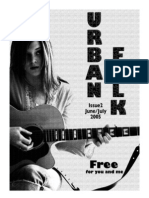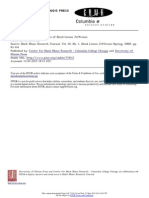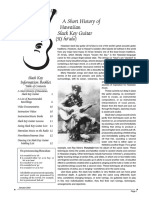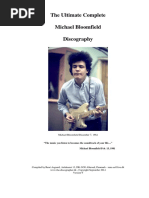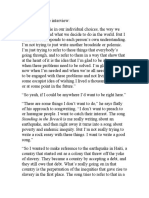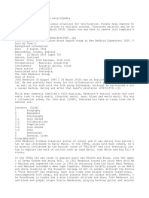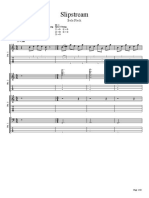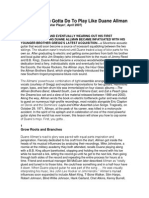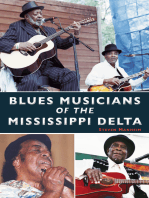Professional Documents
Culture Documents
Lead Belly
Lead Belly
Uploaded by
Steve Lorenz0 ratings0% found this document useful (0 votes)
476 views8 pagesHuddie "Lead Belly" Ledbetter emerged from the oppressive western Louisiana flatlands. He spent most of his creative energies performing at colleges, hootenannies, clubs. Rounder's reissues of his Ubrary or Congress Recordings place vivid examples of his artistry back into priot.
Original Description:
Copyright
© Attribution Non-Commercial (BY-NC)
Available Formats
PDF, TXT or read online from Scribd
Share this document
Did you find this document useful?
Is this content inappropriate?
Report this DocumentHuddie "Lead Belly" Ledbetter emerged from the oppressive western Louisiana flatlands. He spent most of his creative energies performing at colleges, hootenannies, clubs. Rounder's reissues of his Ubrary or Congress Recordings place vivid examples of his artistry back into priot.
Copyright:
Attribution Non-Commercial (BY-NC)
Available Formats
Download as PDF, TXT or read online from Scribd
Download as pdf or txt
0 ratings0% found this document useful (0 votes)
476 views8 pagesLead Belly
Lead Belly
Uploaded by
Steve LorenzHuddie "Lead Belly" Ledbetter emerged from the oppressive western Louisiana flatlands. He spent most of his creative energies performing at colleges, hootenannies, clubs. Rounder's reissues of his Ubrary or Congress Recordings place vivid examples of his artistry back into priot.
Copyright:
Attribution Non-Commercial (BY-NC)
Available Formats
Download as PDF, TXT or read online from Scribd
Download as pdf or txt
You are on page 1of 8
The Library
of Congress
Recordings.
Ce Bed
Alan Lomax
Introduction
Late in 1934 Huddie "Lead Belly" Ledbetter emerged from the oppressive western Louisiana flatlands,
where he had been almost literally unearthed by John and Alan Lomax, into another world, Courted by
liberal whites for whom he symbolized the racist South, Lead Belly soon settled in New York City. And he
all but ceased playing for fellow African Americans. Instead, he spent most of his creative energies
performing at colleges, hootenannies, clubs as well as for Communist functions, events to raise money to
support union-organizing, or other related causes. By the time of his death in 1949, brief stints in
Hollywood and Paris had brought Ledbetter new recording opportunities and an international following. If
Huddle Ledbetter had not been born, his colorful life could have the product of a creative and imaginative
writer.
Rounder's reissues of Huddie Ledbetter's Library of Congress Recordings place these vivid examples of his
artistry back into print. Many of the selections were first issued by Elektra (301/302) as part of a project
masterminded by Larry Cohn, However, this boxed set has been unavailable for many years. These
recordings from between 1934 and 1942 contain some of Lead Belly’s most powerful work and sample his
wide repertoire. Most of Lead Belly’s biggest fans and supporters, such as Alan Lomax and Larry Cohn,
consider the Library of Congress recordings to be his strongest work.
Moreover, these three volumes contain the earfiest
These performances of “Irene,” “Frankie and Albert,” “Ella Speed,” “Roberta,
Blues” and “Alberta” remain definitive. They are also some of the finest and most inventive examples of
folk music. We are fortunate that John and Alan Lomax stressed not only the breadth of Lead Belly’s
repertoire, but also his various styles. These guitar-accompanied selections include stunning examples of
Huddie's slide work, while others focus on his titanic voice. The 1940 session contains a large number of
sacred pieces and narratives about religion. Lead Belly’s stock of children's songs remain the only aspect of
Lead Belly’s repertoire that is not well-represented. Aside from this short-coming, the Library of Congress
recordings represents a grand sampling of one of the strongest musical personalities in twentieth-century
“American vernacular music.
Lead Belly's Life
Despite the fame he gained in later life, the details of Lead Belly’s early years remain enigmatic, His
peripatetic life as an itinerant musician makes it difficult to learn much about his past. Even in the closing
years in New York City, Huddie did not speak of the days before meeting the Lomaxes. As well as Pete
Seeger knew Lead Belly, he cannot recall Huddie ever talking about Texas, Louisiana, or his various brushes
with the law. Lead Bell's in-concert patter and song preambles often referred to his days in Shreveport,
older relatives, and Blind Lemon Jefferson, Concrete information, however, is more difficult to obtain.
The fact remains that Huddie Ledbetter was bom just south of Mooringsport, Louisiana, in January of 1888.
His sharecropper father, Wes, struggled with the land along the Texas/l ouisiana border. These heady but
tough times in late Reconstruction challenged the heartiest of men, but Wes Ledbetter persevered. He
transcended the bitter cycle of impoverishing sharecropping to become a landowner, supporting his wife
Sallie, young Huddie, and their adopted daughter Australia, with a small degree of comfort. This marginal
security permitted Huddie to attend school, a luxury denied to most of his friends.
Wes's extended family exposed Huddie to music at an early age. Huddie also followed local guitar players
Bud Coleman and jim Fagin, from whom he learned pieces such as “Po’ Howard” and “Green Com.” That
Lead Belly does not recall hearing blues in the middle-to-late 1890s is not surprising for this genre was just
evolving from the field hollers, ring shouts, Native American ballads, dance tunes, and vocal quartets that
dominated African American vernacular music in the late nineteenth century.
By the tum of the century Huddie became a regular at the breakdowns (country parties) and sukey-jumps
(Square dances) around Mooringsport. His reputation as a musician kept him in demand and most Saturday
nights were spent entertaining revelers. The opportunity to gamble, drink, and dance lured scores of people
to these important social events, Violence often occurred, Huddie's first brush with the law came at a
sukey-jump when he shot at a man who bothered his girlfriend, Eula Lee, resulting in a twenty-five dollar
fine for carrying a concealed weapon. Huddie Ledbetter soon graduated to Fannin Street, Shreveport's
notorious open red-light district where the “good life” lasted twenty-four hours every day. As early as 1901
Lead Belly’s music took him on the road and away from Mooringsport. The details from this period of his
life are particularly lacking, Just shy of twenty years old Huddie married his first wife, Lethe, and by, 1910
they had settled into a more domesticated state. They worked the land in order to bring in a regular cotton
crop, but the stability of marriage and living in New Boston, Texas, did not last long, Huddie's appetite for
women, breakdowns, and music proved too irresistible. Soon he was back in trouble) first withjan assault
charge pressed by a woman near Marshall, Texas. Eventually, he and Lethe had completely separated
Around 1915 he met Blind Lemon Jefferson, who later gained fame as a Paramount recording artist and
emerged as one of the most respected Texas blues songsters. The two rambled together for months,
playing music and living like archetypal “rounders”. But before long Huddie was back in trouble on a series
of petty charges. He escaped from jail, laped back to Mooringsport, and was hidden by his father. Lead
Belly became known as “Walter Boyd,” the alias under which he was arrested in December 1917, for
shooting Will Stafford, This assault finally resulted in a thirty-year sentence at Shaw State Prison Farm,
where Huddie remained until 1925. Here Lead Belly learned to cope with and even exploit the system
through his musical talents. The guards enjoyed his guitar playing, which eamed him special attention and
dispensation. The most precious gift brought by his music (a pardon issued by Texas governor, Pat Neff)
came after Lead Belly sang for Neff, who visited the prison in the spring of 1924.
Lead Belly eventually returned to Mooringsport and soon landed a job driving a truck for the Gulf Refining
Company. He also returned to his old life-style: playing music, attending breakdowns, drinking, gambling,
and womanizing, Prohibition created an even greater demand for bootleg liquor and urban centers such as
Shreveport attracted an increasing number of rural blacks in search of better job opportunities. Lead Belly
enjoyed a large measure of local respect as a musician of great ability, whose guitar playing and singing got
him out of the penitentiary. He remained somewhat envious of his buddy Blind Lemon, who emerged as
‘one of the “race record” stars of the late 1920s.
Lead Belly eventually turned back to the marginal living afforded to him through his music. He left the safe
life behind and again became entangled in the violence that characterized his musical world, He barely
avoided jail on several occasions in the late 1920s, even shooting a fellow rounder and evading prosecution.
Finally in 1930 even Lead Belly's immense skill at evading the law came up short; he was convicted of
assault with intent to murder. For the foreseeable future the notorious Louisiana State Penitentiary in
Angola became his home. Lead Belly, in fact, remained incarcerated in Angola for several years. In the hot
summer of July 1933, Alan and John Lomax visited the Penitentiary in search of inmates who knew
folksongs: blues, ballads, religious material, and worksongs. Lead Belly's prowess with the |2-string guitar
had become well known to everyone within the prison community and he was soon brought to the
Lomax’s attention, The power and extent of Lead Belly's talents became immediately apparent to John and
Alan Lomax whose |933 trip through the Deep South was to yield scores of fine recordings, But, none of
their work brought them more attention than their discovery of the self-described “King of the Twelve-
Swing Guitar.”
With the Lomaxes assistance Lead Belly secured his release from the custody of the State of Louisiana by
way of a pardon from Governor O.K. Allen, Lead Belly became a free man and by the fall of 1934 he began
working as John Lomax’s chauffeur: In early 1935 Lead Belly’s long-time woman friend, Martha, joined them
and they married on January 2st at the home of one of the Lomax family’s friends in Wilton, Connecticut.
His wedding day also included a brief recording session for the Library of Congress. Between 1937 and
1942. Huddie, now permanently relocated in New York City, traveled to Washington D.C. several times to
record for Alan Lomax and the Folksong Archive of the Library of Congress
From the time he left the South in the fall of 1934, Lead Belly lived in a far different world than his Texas
and Louisiana homes, For about one year he appeared weekly on New York City’s public radio station
(WNYC) and Lead Belly welcomed the gigs that came along, for he and Martha struggled to survive. They
were on and off welfare, a tough position for a man with Lead Belly’s pride. Yet the enticement of
commercial success always loomed close; in 1939 and 1940 he took the opportunity to record for
Musicraft and Victor, Unfortunately these recordings proved to be poor sellers. Moe Asch provided Huddie
with other opportunities beginning in 1941, Many of these records remain in print as part of the
Smithsonian/Folkways catalogue and constitute his second greatest recorded legacy. But by 1948 Huddie
was back in New York City, ving with Martha and trying to scuffle by with his musical talents. In the spring
of 1949 Lead Belly began to tire more quickly; his still spry athletic frame required more rest. Within
several months the doctors issued a fatal diagnosis: lateral sclerosis, aka. Lou Gerhig's disease. This
degenerative disease of the muscular system sent Huddie into decline and on December 6, 1949 he died
In retrospect Lead Belly’s repertoire and twelve-string guitar playing have influenced a multitude of
musicians. Gordon Parks directed a major motion picture based on his first forty-six years that Paramount
released in 1976. The Smithsonian/Folkways catalogue contains scores of Hucddie’s songs, most notably the
“Final Sessions" set produced by Frederic Ramsey. Furthermore, the Smithsonian Institution celebrated the
artistry of Woody Guthrie and Huddie Ledbetter as part of their much-acclaimed 1988 “Vision Shared”
television documentary and Columbia recording. Lead Belly may be long dead but his legacy remains a
powerful force.
—Kip Lomnell
Office of Folklife Programs
Smithsonian Institution
The Songs—Volume One
This volume concentrates on his earliest Library of Congress performances, the first of which were
recorded while Lead Belly was stil incarcerated in Angola Penitentiary. Most of these songs are blues or
ballads. Their sources run from the traditional song about cocaine abuse “Take A Whiff on Me" to
Huddie's very personal plea for a pardon from "Governor OK. Allen.” Although each song bears Lead
Belly’s unmistakable stamp, the sources for some of them remain ambiguous.
Despite the assured references to Lead Belly's authorship of “Goodnight Irene,” its origins actually remain
quite muddy. As early as 1963 Lead Belly enthusiast John Reynolds pointed out that a prototype of “Irene”
appeared in print in 1888. The group that published the song, Haverly's United American European
Minstrels, aso performed in northwestern Louisiana in the late 1880s, The “Midnight Special” presents
another interesting situation. It was recorded on commercial discs as early as 1925 by Sodarisa Miller and
by Sam Collins two years later. Their versions are clearly related to Lead Belly's, though they are not
‘textually or musically identical. In both cases it would appear that Huddie drew from his reservoir of oral
tradition and “composed” two songs with which he will forever be linked.
Another song, "Matchbox Blues.” is clearly linked with another Texas songster—Blind Lemon jefferson. The
two men ran together during the middle teens, but it’s unclear whether Huddie leaned this version directly
from his buddy or from a later recording, “Ella Speed” is a second Texas-associated ballad that Lead Belly
often performed. Then there is “Frankie and Albert,” which can be traced back to the late nineteenth
century. Other black Texas musicians, such as Nick Nichols and Mance Lipscomb, recorded the song,
sometimes titled "Frankie and Johnny.” Although it was not recorded commercially until the years following
World War Two, “Roberta'’ is another song that seems to be a particular favorite of Texas musicians
The rest of the titles heard on this volume are more squarely from the blues tradition. "De Kalb Blues"
makes references to a small town in northeastem Texas in which Huddie lived during the early teens. Both
“Red River” and "I'm Sorry Mama'" are derived from oral tradition, The set closes with one of the best
known of blues ballads, “Careless Love,” which also appeared in the repertoire of early hillbilly singers lke
Byrd Moore and Riley Puckett.
Also available:
Lead Belly: The Library of Congress Recordings, Volume 2 (Rounder 1045)
Lead Belly: The Library of Congress Recordings, Volume 3 (Rounder 1046)
You might also like
- Son House Ebook - CompleteDocument44 pagesSon House Ebook - Completemanu100% (6)
- Aereo Plane Banjo TabDocument2 pagesAereo Plane Banjo TabAnthony Bacon100% (2)
- Yazoo RecordsDocument5 pagesYazoo RecordsSteve GOopNoch keine Bewertungen
- Introduction and First Two Chapters of Woman With Guitar: Memphis Minnie's BluesDocument26 pagesIntroduction and First Two Chapters of Woman With Guitar: Memphis Minnie's BluesCity Lights100% (5)
- Piedmont BluesDocument4 pagesPiedmont Bluesbill100% (1)
- CharliePoole HighWide&HandsomeDocument37 pagesCharliePoole HighWide&HandsomehugoNoch keine Bewertungen
- Atlanta Blues History 1933Document34 pagesAtlanta Blues History 1933hugoNoch keine Bewertungen
- Louisville Jug Music: From Earl McDonald to the National JubileeFrom EverandLouisville Jug Music: From Earl McDonald to the National JubileeNoch keine Bewertungen
- Country BluesDocument6 pagesCountry BluesahtlacatlNoch keine Bewertungen
- Tiny Moore (Frets Article)Document4 pagesTiny Moore (Frets Article)Fernando DuarteNoch keine Bewertungen
- Western Piedmont Blues in VirginiaDocument18 pagesWestern Piedmont Blues in VirginiaGustavoLadino100% (1)
- Bob Brozman: The Evolution of The 12 Bar Blues ProgressionDocument4 pagesBob Brozman: The Evolution of The 12 Bar Blues ProgressionPoss HumNoch keine Bewertungen
- Eric Bibb - Jericho Road (Liner Notes)Document30 pagesEric Bibb - Jericho Road (Liner Notes)Stony Plain Records100% (1)
- Delta BluesDocument4 pagesDelta BluesCyrus Yu Shing ChanNoch keine Bewertungen
- BB KingDocument10 pagesBB KingSrujan MaNoch keine Bewertungen
- Dave Apollo - MandozineDocument5 pagesDave Apollo - MandozinebrunoadamNoch keine Bewertungen
- Pettersen DownBeat Feb2004Document1 pagePettersen DownBeat Feb2004rickmetzijnneusNoch keine Bewertungen
- 167 Eddie Lang Web Layout 1 PDFDocument10 pages167 Eddie Lang Web Layout 1 PDFdavidpuenterivasNoch keine Bewertungen
- I Believe I'll Go Back Home: Roots and Revival in New England Folk MusicFrom EverandI Believe I'll Go Back Home: Roots and Revival in New England Folk MusicNoch keine Bewertungen
- Urban Folk-Issue 2Document32 pagesUrban Folk-Issue 2urbanfolkNoch keine Bewertungen
- Blues Music Magazine Issue 8Document68 pagesBlues Music Magazine Issue 8blues81Noch keine Bewertungen
- Todd Titon Jeff - The Life StoryDocument18 pagesTodd Titon Jeff - The Life StoryLazarovoNoch keine Bewertungen
- Grandpa JonesDocument13 pagesGrandpa JonesPig de Long Mac Oink IIINoch keine Bewertungen
- Lenny BreauDocument3 pagesLenny Breaujoao famaNoch keine Bewertungen
- Blues Roots MississippiDocument10 pagesBlues Roots Mississippijaksach75% (4)
- Blind Lemon Jefferson PDFDocument35 pagesBlind Lemon Jefferson PDFHolley Wright100% (3)
- Legends of Country Blues Guitar Vol. 3 PDFDocument21 pagesLegends of Country Blues Guitar Vol. 3 PDFleosteps50% (2)
- Lap Steel Open G6: Martin TallstromDocument2 pagesLap Steel Open G6: Martin TallstromDaniel FrancoNoch keine Bewertungen
- (E-Book) (Guitar) A Short Hystory of Hawaian Slack Key GuitarDocument12 pages(E-Book) (Guitar) A Short Hystory of Hawaian Slack Key Guitarcippolippo123Noch keine Bewertungen
- List of Dire Straits Band MembersDocument3 pagesList of Dire Straits Band MembersBonnie ThompsonNoch keine Bewertungen
- Highway 61 Revisited.Document321 pagesHighway 61 Revisited.stationtwo100% (1)
- Eddie Lang - PreludeDocument2 pagesEddie Lang - PreludeCleber Guimarães50% (2)
- Bloomfield DiskoDocument170 pagesBloomfield Diskopinomarrone100% (1)
- Lesson 9 - Blind Willie McTell and The Piedmont Style Part 2Document2 pagesLesson 9 - Blind Willie McTell and The Piedmont Style Part 2julioguerreiro100% (2)
- Papers: Andy RazafDocument15 pagesPapers: Andy RazafGasy Cool0% (1)
- Diddie Wa DiddieDocument5 pagesDiddie Wa DiddieGene Stoltz100% (3)
- Blues Origins Spanish Fandango and SebastopolDocument9 pagesBlues Origins Spanish Fandango and SebastopolPoss Hum100% (1)
- Sligo Rags in Flatpicking Guitar MagazineDocument5 pagesSligo Rags in Flatpicking Guitar MagazineSligo RagsNoch keine Bewertungen
- The Blues GiantsDocument136 pagesThe Blues GiantsGustavoLadino100% (2)
- Ike Quebec - DiscographyDocument24 pagesIke Quebec - DiscographyGeorgeNoch keine Bewertungen
- Jackson Browne-Words of WisdomDocument7 pagesJackson Browne-Words of WisdomBill FairfieldNoch keine Bewertungen
- Anji Tab by Simon and GarfunkelDocument4 pagesAnji Tab by Simon and GarfunkelnanglessNoch keine Bewertungen
- Welcome To The Jazz PortalDocument10 pagesWelcome To The Jazz PortalXenon RavenNoch keine Bewertungen
- Eric Bibb - Blues People (CD Liner Notes)Document30 pagesEric Bibb - Blues People (CD Liner Notes)Stony Plain Records100% (1)
- Skip James MedleyDocument4 pagesSkip James Medleysantiago100% (2)
- Mike Bloomfield: Beyond Blues PhrasesDocument7 pagesMike Bloomfield: Beyond Blues PhrasesPinoVentriglioNoch keine Bewertungen
- John RenbournDocument3 pagesJohn RenbournpetersoneduNoch keine Bewertungen
- Duke Robillard Biography For Release of His Band's New Album "Low Down and Tore Up"Document2 pagesDuke Robillard Biography For Release of His Band's New Album "Low Down and Tore Up"Stony Plain RecordsNoch keine Bewertungen
- Jerry "Boogie" McCainDocument35 pagesJerry "Boogie" McCainDave van BladelNoch keine Bewertungen
- Slipstream Bela FleckDocument36 pagesSlipstream Bela FleckjuanilaescaleraNoch keine Bewertungen
- Whos Who Jazz Guitarists COMPLETE PDFDocument30 pagesWhos Who Jazz Guitarists COMPLETE PDFCamilo GaiteNoch keine Bewertungen
- BMG - 1964 - 07 2Document36 pagesBMG - 1964 - 07 2benjamin demolin100% (1)
- Mandolin Workshop With Herman Towles and Fiddle Workshop With Branson RainesDocument1 pageMandolin Workshop With Herman Towles and Fiddle Workshop With Branson RainesJennifer Brown BryanNoch keine Bewertungen
- Jazz Archivist Vol26 2013Document40 pagesJazz Archivist Vol26 2013Kathryn Hobgood Ray100% (1)
- 10 Things You Gotta Do To Play Like Duane AllmanDocument8 pages10 Things You Gotta Do To Play Like Duane AllmanErick Ramone100% (1)
- Emergency! Race and Genre in Tony Williams's LifetimeDocument28 pagesEmergency! Race and Genre in Tony Williams's LifetimeStefano Zenni100% (2)
- Blind Lemon Blues Education GuideDocument18 pagesBlind Lemon Blues Education GuideThe Blusician100% (3)
- Nick Paumgarten 'Annals of Obsession' New Yorker 11.19.12Document24 pagesNick Paumgarten 'Annals of Obsession' New Yorker 11.19.12JP BeausoleilNoch keine Bewertungen



















